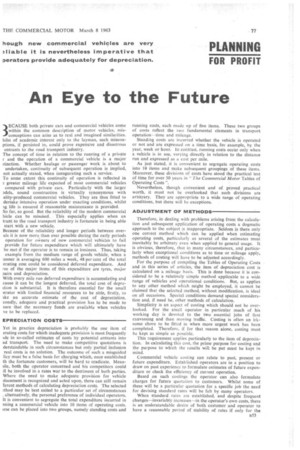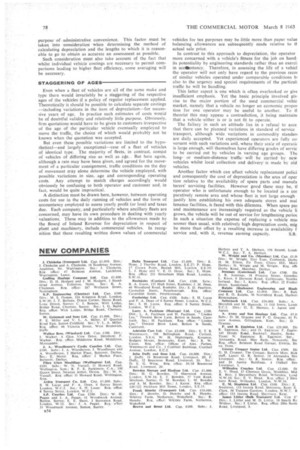An Eye to the Future
Page 79

Page 80

If you've noticed an error in this article please click here to report it so we can fix it.
3ECAUSE both private cars and commercial vehicles come within the common description of motor vehicles, misconceptions can arise as to real and imagined similarities. hilst of academic interest only to the layman, such misconptions, if persisted in, could prove expensive and disastrous entrants to the road transport industry.
The concept of time in relation to the running of a private r and the operation of a commercial vehicle is a major itinction. Whether haulage or passenger work is about to undertaken, continuity of subsequent operation is implied, not actually stated, when inaugurating such a service.
To some extent this continuity of operation is reflected in ! greater mileage life expected of most commercial vehicles compared with private cars. Particularly with the larger Weis, sound construction is virtually synonymous with ality-produced commercial vehicles. They are thus fitted to dertake intensive operation under exacting conditions, whilst ag life is ensured if reasonable maintenance is provided.
So far, so good, But the reliability of the modern commercial hick can be misused. This especially applies when an trant to the road transport industry is fortunate in being able start with a new vehicle.
Because of the reliabilitY and longer periods between overuls it is now more than ever possible during the early periods operation for oWners of new commercial vehicles to fail provide for future expenditure which will ultimately have be met if the operator is to remain in business. Thus, taking example from the medium range of goods vehicle, when a .onner is averaging 600 miles a week, 48 per cent of the total erating cost could be considered deferred expenditure. And ree of the major items of this expenditure are tyres, major pairs and depreciation.
With every mile run deferred expenditure is accumulating and cause it can be the longest deferred, the total cost of depreition is substantial. It is therefore essential for the small erator with limited financial resources to be able, firstly, to Ike an accurate estimate of the cost of depreciation. condly, adequate and practical provision has to be made to sure that the necessary funds are available when vehicles ye to be replaced. .
EPRECIATION COSTS Yet in practice depreciation is probably the one item of erating costs for which inadequate provision is most frequently We in so-called estimates of costs by potential entrants into ad transport The need to make competitive quotations is derstandable in such circumstances but only partial inclusion real costs is no solution. The outcome of such a misguided licy must be a false basis for charging which, once established th the fortunate customers, will be hard to eradicate. Meanmile, both the operator concerned and his competitors could 1i be involved in a rates war to the detriment of both parties. Where the need to make adequate provision for vehicle )1acement is recognized and acted upon, there can still remain Terent methods of calculating depreciation costs. The selected :thod may be best suited to a particular set of circumstances , alternatively, the personal preference of individual operators. It is convenient to segregate the total expenditure incurred in nning a commercial vehicle into 10 items of operating costs. tese can be placed into two groups, namely standing costs and running costs, each made up of five items. These two groups of costs reflect the two fundamental elements in transport operation—time and mileage.
Standing costs are incurred whether the vehicle is operated or not and are expressed on a time basis, for example, by the year, week or hour. In contrast, running costs occur only when a vehicle is in use, varying directly in relation to the distance run and expressed as a cost per mile.
As just stated, it is convenient to segregate operating costs into 19 items and make subsequent groupings of these items. Moreover, these divisions of costs have stood the practical test of time for over 50 years in " The Commercial Motor Tables of Operating Costs ".
Nevertheless, though convenient and of proved practical worth, it must not be overlooked that such divisions are arbitrary. They are appropriate to a wide range of operating conditions, but there will be exceptions.
ADJUSTMENT OF METHODS Therefore, in dealing with problems arising from the calculation and subsequent application of operating costs a dogmatic approach to the subject is inappropriate. Seldom is there only one correct method which can be applied when estimating operating costs, particularly as several of the estimates must inevitably be arbitrary even when applied to general usage. It is obvious, therefore, that in many circumstances, and particularly when exceptional conditions as to time or mileage apply, methods of costing will have to be adjusted accordingly.
For the purpose of compiling the Tables of Operating Costs and in this series of articles, the item of depreciation cost is calculated on a mileage basis. This is done because it is considered to be a relatively simple method applicable to a wide range of vehicles and operational conditions. But, as applies to any other method which might be employed, it cannot be claimed that the selected method, without modification, is ideal on all occasions. Special conditions demand special consideration and, if need be, other methods of calculation.
Simplicity is an aspect of costing which should not be overlooked. For the small operator in particular much of his working day is devoted to the two essential jobs of first canvassing and then moving traffic. Costing is often an irksome chore to be fitted in when more urgent work has been completed. Therefore, if for that reason alone, costing must be kept as simple as possible.
This requirement applies particularly to the item of depreciation. In calculating this cost, the prime purpose for costing and the purpose to which the results will be put must be kept in mind.
Commercial vehicle costing can relate to past, present or future expenditure. Established operators are in a position to draw on past experience to formulate estimates of future expenditure or check the efficiency of current operation.
Based on such costings the operator can also formulate charges for future quotation to customers. Whilst some of these will be a particular quotation for a specific job the need for devising standard rates will be felt by many operators.
When standard rates are established, and despite frequent changes—invariably increases—in the operator's own costs, there is an understandable desire of both customer and operator to have a reasonable period of stability of rates if only for the
purpose of administrative convenience. This factor. must be taken into .consideration -when determining the method of calculating depreciation and the lengths to which it is reasonable to go to obtain as accurate an assessment as possible.
Such consideration must also take account of the fact that whilst individual vehicle'costings are necessary to permit comparisons leading to higher fleet efficiency, some averaging will be necessary.
STAGGERING OF AGES
Even when a fleet of vehicles are all of the same make and type there would invariably be a staggering of the respective ages of the vehicles-if a policy of regular replacement applied. Theoretically it should be possible to calculate separate costings —including variations in the item of depreciation—for successive years of age. In practice such estimates of costs would be of doubtful validity and relatively little purpose. Obviously, firm quotations would have to be given to customers irrespective of the age' of the particular vehicle eventually employed to move the traffic, the choice of which would probably not be known when the quotation was accepted.
But even these possible variations are limited to the hypothetical—and largely exceptional—case of a fleet of vehicles of identical type. The Majority of fleets, in contrast, consist of vehicles of differing size as well as age.. But here again, although. a rate may have been. given, and agreed for. the movement of a particular consignment, traffic conditions on the day of movement way alone determine the vehicle employed, with possible variations in size,_age and corresponding operating costs. Any attempt to match charges accordingly would obviously be. confusing to both operator and customer and, in fact, would be quite impractical.
A distinction must be drawn here, however, between operating costs for use in the daily running of vehicles and the form of accountancy employed to assess yearly profit (or loss) and taxes due. Each company, and particularly where ancillary fleets are concerned, may have its own procedure in dealing with yearly valuations. These may in addition to the allowances made by the Board of Inland Revenue for depreciation in respect of plant and machinery, include commercial vehicles. In recognition that these resulting written down values of commercial vehicles for tax purposes may be_little more than paper value balancing allowances are subsequently made relative to ti actual sale price.
In contrast to this approach to depreciation, the operator more concerned with a vehicle's fitness for the job on bandits potentiality by engineering standards rather than an exerci in acctlintancy. Therefore, in assessing the life of a vehicl the operator will not only have regard to the previous recoi of similar vehicles operated under comparable conditions bi also to the urgency and special requirements of the partica traffic he will be handling.
This latter aspect is one which is often overlooked or givs insufficient emphasis. Yet the basic principle involved giv rise to the major portion of the used commercial vehic market, namely that a vehicle no longer an economic propos tion for one operator may be useful to another. To tl theorist this may appear a contradiction, it being maintains that a vehicle -either is or is not fit to operate.
The fallacy in such an attitude lies in a refusal to acce that there can be planned variations in standard of service transport, although wide variations in commodity standaro are daily accepted. Yet experienced operators are fully co versant with such variations an'd, where their scale. of operatic is large enough, will themselves have differing grades of servie to be carried out by vehicles in varying age groups. Thu longor medium-distance traffic-will be carried. by. neW vehicles whilst local collection and delivery .is made by old vehicles.
Another factor which can affect vehicle replacement polici and consequently the cost of depreciation is the area Of oper tion relative to the availability of spare parts and manufa turers' servicing facilities. However good these may be, ti operator who is unfortunate enough to be located in a cor paratively remote area and whose fleet is not large enough justify him establishing his own adequate stores and mai tenance facilities, is faced with this dilemma. When spare pal and maintenance are increasingly required as the vehicle Ii grows, the vehicle will be out of service for lengthening perioc In such a situation the expense of replacing a vehicle rim sooner than usual, with relatively high depreciation costs, rnig be more than offset by a resulting increase in availability f
service and, with it, revenue earning capacity. S.B.




















































































































